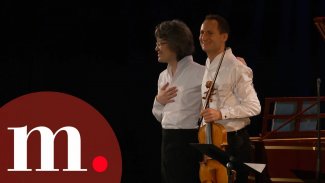




Masato Suzuki
Links
Download Assets
“[Suzuki’s] phrases are stunningly articulated, teeming with nuance and character. The section in the relative minor is particularly delightful … Suzuki handles this phrase, which in this arrangement could easily become a demonstration of moto perpetuo drill, with the subtle shaping and minutiae of timing and touch that are the hallmarks of a master harpsichordist.”
(Gramophone Magazine, October 2019)
Principal Conductor: Bach Collegium Japan
Executive Producer: Chofu International Music Festival
Associate Conductor & Creative Partner: Yomiuri Nippon Symphony Orchestra
Music Director: Ensemble Genesis
Masato Suzuki is Principal Conductor of Bach Collegium Japan (BCJ), Conductor/Creative Partner of the Yomiuri Nippon Symphony Orchestra, Music Director of Ensemble Genesis, and Principal Guest Conductor of the Kansai Philharmonic Orchestra. A versatile artist equally at home in baroque and contemporary repertoire, Suzuki is recognized for his refined musicality, stylistic insight, and dynamic leadership.
In the 2025/26 season, Suzuki will have his debut with the Orchestre de Paris, Musica Ricercata, Deutsche Radio Philharmonie, Ankara Presidential Orchestra. He continues his close collaborations with Bach Collegium Japan, leading a new opera production and a concert performance of St. John Passion, and with the Yomiuri Nippon Symphony Orchestra in a series of creative programmes.
Recent conducting highlights include appearances with the NHK Symphony Orchestra, Symphoniker Hamburg, and the Netherlands Bach Society, as well as his debut with the Academy of Ancient Music. Suzuki has directed acclaimed productions in BCJ’s opera series, including Monteverdi’s The Crowning of Poppea, Handel’s Rinaldo (recipient of the 19th Yoshio Sagawa Music Award), and Giulio Cesare, which set new standards for baroque opera in Japan.
Show More
He conducted Gluck’s Orfeo ed Euridice at the New National Theatre Tokyo, directed by Saburo Teshigawara, and Mozart’s Die Zauberflöte with BCJ and the Tokyu Group. In 2025, he will return to this collaboration for a new production of Don Giovanni.
Suzuki’s distinguished discography includes numerous recordings with Bach Collegium Japan, notably the complete sacred and secular cantatas of J.S. Bach, and a duo album of Bach’s Sonatas for Viola da Gamba and Harpsichord with Antoine Tamestit, praised as “stunningly articulated” (Gramophone) and nominated for an International Classical Music Award. His solo recording of The Well-Tempered Clavier, Book I was described as “Suzuki at his best” (The Guardian).
A graduate of the Royal Conservatoire the Hague and Tokyo University of the Arts, Suzuki is a recipient of the 71st Minister of Education Newcomer’s Art Encouragement Award, the 18th Hideo Saito Memorial Fund Award, the Hotel Okura Music Award, and the Akio Watanabe Music Foundation Award. He is Executive Producer of the Chofu International Music Festival and a visiting professor at Kyushu University.
Contacts
Jasper Parrott Executive Chairman HP Group & Associated Companies Federico Hernandez General Manager HarrisonParrott Madrid & Latin American Business
worldwide general management
Federico Hernandez General Manager HarrisonParrott Madrid & Latin American Business
worldwide general management
Season Highlights
Macau International Music Festival
Show more about Macau International Music Festival
JOHANN SEBASTIAN BACH: St. Matthew Passion, BWV 224
“It wasn’t just [Leo] Duarte who shone, in the first-half cantata sinfonias, but also [Masato Suzuki] in a surprising manifestation of what we know best as the outer movements of the D minor Harpsichord Concerto. As sinfonias for two more cantatas, they sounded startlingly different in the collaboration between the players and the conductor at the chamber organ, a virtuosic tour de force which twice stole the show.”
“[Suzuki’s] phrases are stunningly articulated, teeming with nuance and character. The section in the relative minor is particularly delightful … Suzuki handles this phrase, which in this arrangement could easily become a demonstration of moto perpetuo drill, with the subtle shaping and minutiae of timing and touch that are the hallmarks of a master harpsichordist.”
“Tamestit and his partner Masato Suzuki achieve a communicative and spontaneous rapport … a fascinating adjunct to the programme is their arrangement for viola and harpsichord of the fervent tenor aria with viola obbligato – an almost unique occurrence of the instrument in this role in Bach’s cantatas – from “Wo soll ich flienhen hin?” (BWV5).”
“With the harpsichordist Masato Suzuki, Antoine Tamestit gives Bach’s three viola da gamba sonatas on his 1672 Stradivarius viola, albeit using a baroque bow and tuning to baroque pitch. The contrast with the thinnish sonorities of the fretted, six-stringed viola da gamba is stark, Tamestit producing a luscious array of velvety colours and luxuriant phrasing. Heresy, some might say, but it works beautifully.”
“Suzuki’s hands moved seamlessly between the two manuals adding to the drama of this richly scored work. The accompanying period instruments produced a lively orchestral sound centred around the dynamic viola interactions with the harpsichord … Suzuki took full advantage of the opportunity to show off the full extent of the Taskin’s bright tonal colours with his dazzling account of Bach’s virtuosic Italian Concerto for solo harpsichord.”









